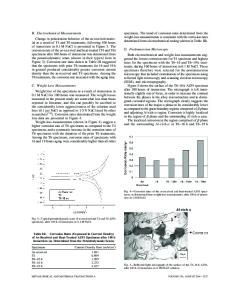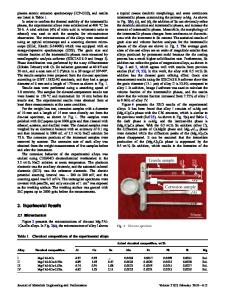Microstructure and Corrosion Characterization of Squeeze Cast AM50 Magnesium Alloys
- PDF / 864,889 Bytes
- 9 Pages / 593.972 x 792 pts Page_size
- 35 Downloads / 346 Views
I.
INTRODUCTION
DEMAND is growing in the automotive industry for vehicle weight reduction using lightweight alloys. Magnesium alloys, in particular, have shown significant potential for lightweighting in automotive applications because of their lower density compared with aluminum in addition to their excellent machinability and damping capacity.[1] A combination of material design and process development is required to achieve the optimum microstructure for desired strength and corrosion properties for specific automotive applications. Among the currently used magnesium alloys, the Mg-Al systems offer reasonably high strength properties at room temperature and increasingly are finding use in several automotive applications. The following types of Mg-Al alloys are commonly are used for auto applications: MgAl-Zn (AZ) and Mg-Al-Mn (AM) series alloys. A review of the microstructure and mechanical properties of AM series alloys and the new Mg-Al-Sn (AT) series alloys has been provided by Luo and Sachdev.[2] A proper combination of strength, toughness, and corrosion resistance has been a major challenge for Mg alloys. Some studies indicate that adding alloying elements such as rare earth elements to Mg alloys produces substantial DEEPIKA SACHDEVA, Researcher, SHASHANK TIWARI, Senior Researcher, and SURESH SUNDARRAJ, Staff Researcher, are with India Science Lab, General Motors Technical Center, Bangalore 560066, Karnataka, India. Contact e-mail: deepika. [email protected] ALAN A. LUO, GM Technical Fellow, is with Chemical Sciences and Materials Systems Lab, General Motors Tech Center, Warren, MI 48093. Manuscript submitted August 18, 2010. Article published online September 16, 2010. METALLURGICAL AND MATERIALS TRANSACTIONS B
improvements in strength, toughness, and corrosion resistance.[3–5] In terms of the choice of a manufacturing process, the preferred casting route for producing automotive components has primarily been the high-pressure die casting (HPDC) process. Although HPDC is a preferred method for producing components with thinner cross sections such as the instrument panel beam, this process cannot be adopted to produce parts with thicker casting cross sections (e.g., control arms and knuckles in the chassis structures) because of porosity issues. For casting thicker sections with Mg, squeeze casting could be a possible choice and currently is being evaluated. Squeeze casting is a liquid-metal-forming process in which the molten metal solidifies under pressure within a reusable die cavity. In this process, an external pressure is applied to a specified quantity of molten metal throughout solidification, which allows the metal to be in close contact with the metallic mold at all times. This intimate contact leads to rapid heat transfer, which yields a high-integrity casting that is substantially free of pores and also has a finer grain size or dendrite arm spacing compared with semipermanent mold casting, the alternative process for making castings with thick sections. Squeeze casting can provide components with mechan
Data Loading...











